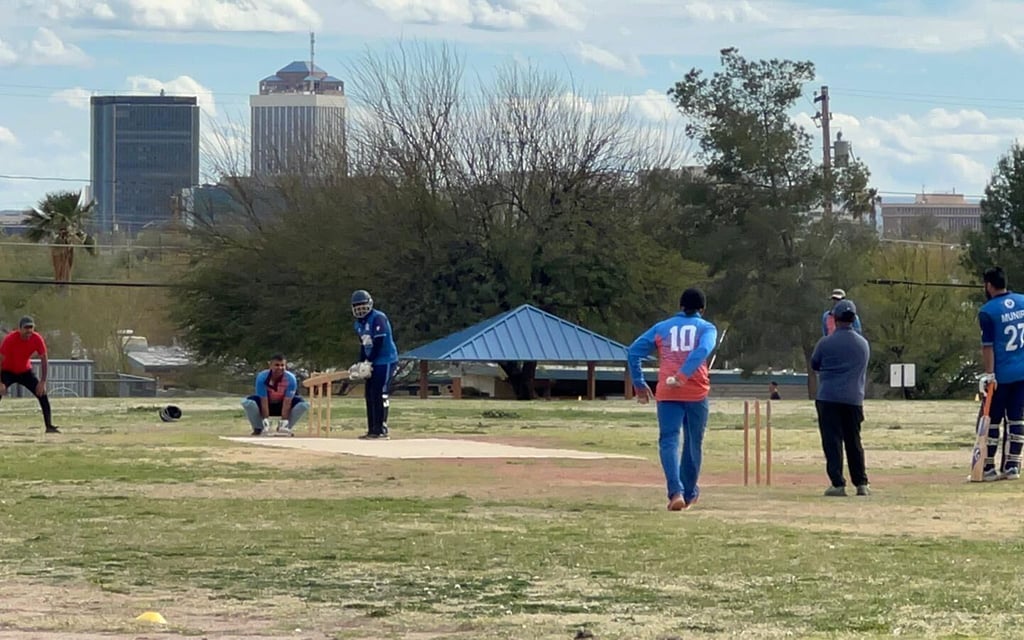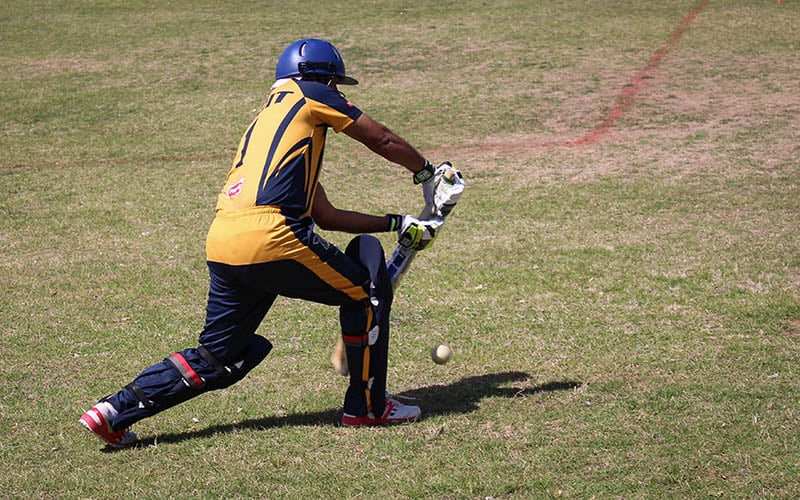PHOENIX – The history books show that at one point cricket was the most popular sport in the United States. The sport evolved, and while its level of interest had declined to some degree since the 1600s, cricket has entered its renaissance period in the United States, reemerging in the last 10-15 years with the influx of South Asians to the United States.
Infrastructure is a major driver of the boom. Around the U.S., cricket stadiums are being erected and more have been proposed as interest grows around the franchise tournaments of Major and Minor League Cricket.
“The United States has the largest sports market in the world,” said international cricket TV commentator Nikhil Uttamchandani. “It was only a matter of time for cricket, which is the second most popular sport in the world to blow up in a country with such a huge sports market.”
With the popularity of cricket rising in the United States, suitable infrastructure is also booming. While progress in Phoenix has been slow, the number of dedicated cricket fields and cricket surfaces is on the rise.
“Early and mid-2000s, there were a limited number of grounds for us and when we asked the city (of Phoenix) to reserve a ground to play cricket, they would say there’s no consideration for cricket, so we had to book those grounds as playing softball,” said Prakash Singh, captain of the Phoenix Cardinals cricket club.
Since then, a lot has changed in the cricket landscape in Arizona. In the last two years, the Arizona Cricket Association has received two dedicated cricket grounds at Legacy Park in Mesa and a couple of natural cricket playing surfaces (astroturfs and natural turfs) in Chandler.
“As the popularity and cricket population is growing, it is getting better,” Arizona Cricket Association chairman Hassan Rafi said about the increase in dedicated cricket playing grounds and surfaces. “The problem is cricket is not perceived as a major sport here, but I think now, that perception is changing as these technology-based companies like Intel and Microsoft are coming to Arizona and with that brings a lot of the South Asian community who all love and play cricket.”
History of cricket in the U.S.
The true origins of cricket are lost in the midst of time. While the existence of cricket was formally documented for the first time in a 1598 court case over a land dispute, the case file states John Derrick testified to playing “creckett” on said land half a century before the case.
Some historians say that the game was invented by children during the Saxon and Norman times.
However, the general consensus is that cricket originated in England. During the 1600s, the sport was played by aristocrats. Cricket changed from the boys’ game to the gentleman’s game as aristocrats were considered to have traits of gentlemen.
Cricket spread throughout the world with the expansion of the British Empire in the 17th and 18th centuries, as soldiers and settlers brought the game to various colonies.
In many parts of the world today, cricket is worshiped like a religion, particularly in South Asian countries like Pakistan, Bangladesh and India.
“Cricket is a very passionate game which brings people from various backgrounds, creeds and races together,” said Sarvesh Karra, an immigrant who came from India in 2001 and one of the founding members of the Metro Stars cricket club, now known as the Phoenix Cardinals cricket club.
In order to understand the state of cricket in Arizona and the United States, look no further than the effect the sport had in the 18th and 19th centuries.
“Cricket was by far the most popular sport in the United States of America in this period,” said Tim Lockley, an expert on American history at Warwick University. “Then the Civil War started in 1861, just when cricket was reaching its peak of popularity. The sport became a victim of that war.”
Football and baseball are thought of as American sports with long and illustrious histories, but cricket predates both. In fact, cricket was played in the U.S. long before it became known as the United States, with historical records showing its existence since 1709, according to USA Cricket.
Two American presidents, George Washington and Abraham Lincoln, even showed interest in the sport, with the former playing a version of cricket called “wickets” with his troops in 1778, and the latter attending a game between Chicago and Milwaukee in 1849, the organization’s website says.
Not even the waning interest of all things British after the American Revolution stopped the popularity of the sport. During the 1800s, cricket was played in 22 states by up to 1,000 clubs.
Cricket’s stagnation and demise was a byproduct of two wars. First, the four-year long Civil War in the 1860s and then World War I. As cricket’s growth and popularity was stunted and eventually faded, baseball’s popularity grew in war camps, as it was hours-long game time compared to cricket, which took days to complete.
Formats of the game
Cricket is a bat-and-ball sport, just like baseball, which was partially derived from cricket. However, the sport features two teams with 11 players each, alternating between batting and fielding (bowling). The bowler on the fielding side, which is the equivalent to a pitcher in baseball, tries to dismiss the batsmen in multiple ways.
The team which scores more runs at the end of a game wins, similar to scoring in baseball. Cricket has evolved not only from a technological standpoint, but in the length of time it takes to complete a game.
Today, cricket has three main versions: a long version called test cricket, which spans five days and each team usually bats and fields two times; a shorter version called one-day cricket, which lasts 8 hours; and an even shorter version called Twenty20 cricket, which lasts roughly two hours and 30 minutes.
The shortest version of the game has been one of the many factors that has made cricket the second-most popular sport in the world.
“I think people had this misconception that cricket was played over five days,” Singh said. “They didn’t know about the various formats, but now I think more and more they are understanding and people from different diversities are joining.”

With an eye on increasing the popularity of cricket, Arizona Cricket Association and city officials work hand-in-hand to expand cricket infrastructure, ensuring a bright future for aspiring cricket players in the state. (Photo courtesy of Phoenix Cardinals)
Cricket in Arizona
Globalization has also played a massive role in the growth of cricket in North America behind the influx of South Asian migrants to Arizona and the United States for work and school purposes. Between 2000 and 2010, for example, the South Asian American population became the fastest growing major ethnic group in the United States, according to the U.S. census.
As a result, the Arizona Cricket Association was formed in 1989, and three teams – Phoenix, Scottsdale and Chandler – made up the original league.
“There were teams formed by the migrant population who played cricket in their respective countries,” explained Vivek Govekar, an administrator and player in the ACA. “There were about three teams and they were playing informal cricket amongst themselves and decided one day to formalize playing against each other by forming the Arizona Cricket Association.”
While the ACA was formed in 1989, it was not until the 2000s that participation in Arizona started gaining steam.
“We were not aware there was some cricket association and league present,” Karra said. “We were staying in an apartment complex and a couple of friends were like, ‘Let’s play some cricket,’ and we found a nearby ground and started playing with a hard tennis ball and that’s how we started initially. Eventually, Mahesh and I got together and formed the Metro Stars. We enrolled the team in the Arizona Cricket Association and eventually we grew from there.”
In the early 2000s, the Arizona Cricket Association had up to 10 teams, though at its peak, the league had 24 teams. Today, there are 22 teams across two divisions with a total of 700 players – and that number is expected to increase in the coming years.
“More and more players are coming in,” Singh said. “This new generation is also very good and while they’re here, they know that they can play cricket just as they did back home and many students are not only into their studies but they’re taking cricket very seriously.”
Arizona State University fields a club team in the Arizona Cricket Association’s competitions as the only university in the state to do so. The team is made up of 12 players, all with South Asian backgrounds. Additionally, two cricket fields at the ASU West Campus are used as home field for the club and the league itself.
“Arizona State University plays a big part in the growth of cricket,” Rafi said. “This year we added an ASU-sponsored cricket team to our organization because of the number of students from India, Pakistan, Sri Lanka and other cricket-playing nations. They come to ASU for studies, but they also look for cricket. Now, ASU is partnering with us and giving ASU facilities to play cricket, so the progression is happening.”
While globalization helps, the National College Cricket Association has also helped since its formation in 2018. It currently has 26 universities competing across two divisions and has steadily grown each year. Arizona State University was the NCCA champion in 2022, while the Division I and II champions this year were Northeastern University and UC Berkeley, respectively.
Cricket infrastructure in Arizona
While the popularity and growth of cricket in Arizona have risen over the last five years in other states such as California, Texas, Atlanta, New York, Florida and Massachusetts, cricket is even more advanced in the states in terms of the number of players and proper infrastructure. Arizona, however, is lacking the latter.
“Our goal as a local cricket body is to work with city officials to get the proper infrastructure so cricket can be played,” Rafi said. “Soon enough, cricket is going to be an Olympic sport and we want the youths of Arizona to represent the United States, but we need the infrastructure for these kids to do well.”
While Rafi and his executive committee have been working with various officials, John Sefton Jr., Community Services Director at city of Chandler, has been instrumental in helping advance cricket grounds and surfaces in Chandler.
“The department and city recognize the diversity of the community,” Sefton Jr. said. “Chandler put the first cricket pitch out in Snedigar Sports Complex many years ago and last year we replaced that surface with an artificial turf. We strive and work toward meeting the needs of the community and just try to make a difference where we can.”
While the city of Chandler has been getting involved, some players want to see other cities in Arizona follow suit.
“I would love to see the city of Phoenix get involved as well,” Karra said. “U.S. cricket has picked up a lot and we pay a lot of money to the city of Phoenix to rent grounds. They need to build more dedicated cricket fields and natural cricket surfaces.
“If the Arizona Cricket Association can go into local public schools and give demos on the rules and game of cricket, that would be great. This is just another way to help spread the word of the game and it would and could help the popularity of the sport. This would then trickle down, as now the city members would have to make available more dedicated cricket grounds.”
Arizona is still behind the curve compared to other states despite its progress. In Northern and Southern California, the leagues have 29 and 40 registered teams, respectively. In Atlanta, there are 66 registered teams with over 1,000 players, playing over 500 games and competing for four championships.
“I would say at this point, cricket in America is more concentrated in the eastern states and California and not really in Arizona,” said Rajan Kale, a player in the Arizona Cricket Association. “It’s still a non-profit organization here and a lot more can be done at the grassroots levels, better infrastructure and youth academies and leagues and that will help the future of cricket and in turn its popularity.”
The past administration of the Arizona Cricket Association failed to build solid relationships with city council members, which Rafi has done since taking office one year ago. And for the future, Rafi has simple plans for the rest of his term in office.
“The major goal is infrastructure,” Rafi said. “Everywhere we play cricket, it either has to be an Astroturf or natural turf, and that way our second goal of starting a youth league can come into fruition.”

Arizona’s cricket landscape has transformed with dedicated grounds and natural surfaces, providing a platform for local talent to shine and contributing to the growth of Minor and Major League Cricket in the country. (File photo by Jerry Walker/Cronkite News)
Cricket infrastructure in the U.S. and Minor and Major League cricket
Cricket is continuously evolving, and with this evolution comes new concepts. Franchise cricket is just that. Essentially, the concept is based on privately-owned teams competing in specific countries and tournaments. Today, franchise leagues can be found in India, Australia, Pakistan, Bangladesh, South Africa, England and the Caribbean.
These teams are predominantly comprised of players from the host league country but also include international players (players from other countries who play for their respective nations).
In 2021, USA Cricket accepted a $1 billion investment bid from American Cricket Enterprises to help develop cricket in America and the national teams. This investment gave way to Major and Minor League Cricket – the newest franchise cricket tournament in the world.
Started in the spring of 2021, Minor League Cricket has had two editions of the tournament and fields 26 teams from four regions. Major League Cricket opened its inaugural season on July 13 after the league was postponed due to the COVID-19 pandemic and the need to develop more facilities.
In Texas, the former home of the Texas AirHogs has been renovated into Grand Prairie Stadium for the Super Kings Cricket team. This 7,200-seat stadium will not only host Major League Cricket but also international cricket and would be a candidate to host matches in the 2024 Twenty20 World Cup, which is co-hosted by the West Indies and United States.
Both teams are automatic qualifiers for the event, after they both failed to qualify for the 2022 ICC Men’s T20 World Cup and the 2023 ICC Men’s Cricket World Cup (one-day internationals). In 2024, USA men’s cricket will qualify for its first ICC T20 World Cup, and the added infrastructure and tournament will be vital to their success in the tournament.
Additionally, Major League Cricket has proposed stadiums in all the states in which there are teams: New York, California, Washington, D.C., Seattle and Texas.
“In the last 15 years cricket has been developing, but since American Cricket Enterprises has come into place, you’ve really seen that exponential growth where teams are competing across the country,” Uttamchandani said. “There’s also been a feeder system of talent being filtered throughout, to help strengthen the U.S. national cricket team, which would only help them become a full cricket playing member.”
Minor League Cricket is a lower level, similar to Minor League Baseball, and consists of more teams spread throughout more states in the U.S. It gives the fans from each respective state an opportunity to have a team to support within cricket.
“These fans now don’t have to only watch cricket on television,” Uttamchandani said. “They can now physically go in person and support them and, from my experience, the support in the last year has been much more than I ever expected. You have fanfare similar to the NFL, where you have fans wanting to buy jerseys and support the cricket in many different ways.”
Minor League Cricket is played in smaller grounds across the United States, helping with the development of the sport with regard to infrastructure.
“This season, there are plans that every minor league game will be played on some type of natural surface,” Uttamchandani said. “It’s massive for the development of the game as it allows players to play on surfaces much more similar to those on the international level.”
Minor League Cricket also focuses on the grassroots levels, as there are specific rules regarding under-19 and under-21 players. Additionally, academies are being opened in states where the minor league is being played.
With regards to Major League Cricket, the excitement for fans is that some of the best international talents, who are household names in cricket are coming for the tournament.
“I honestly think cricket can crack the top three sports in the United States,” Uttamchandani said. “That’s simply based on the high number of South Asian people in the States. Given the way that Twenty20 franchises have grown around the world and the type of players coming to Major League Cricket, it is going to be huge.”


